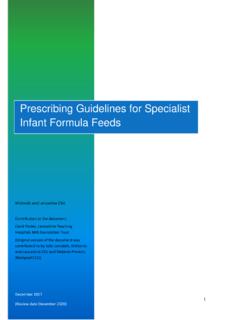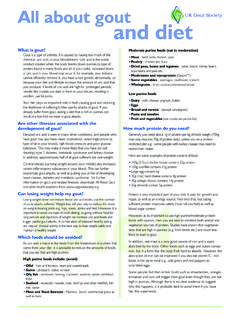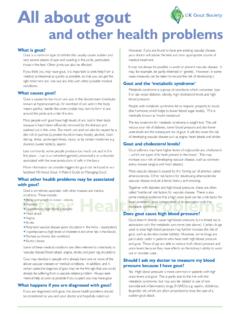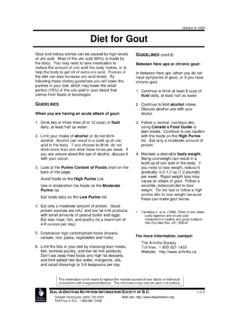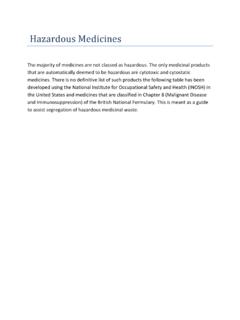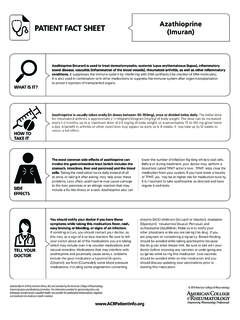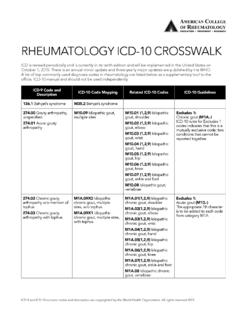Transcription of Gout Management Summary Guidelines (Version 1.1)
1 Page 1 of 3 DO NOT interrupt uric acid lowering therapy unless there is a clinical reason gout flare is NOT a clinical reason)1 gout Management Summary Guidelines (Version ) Acute gout Management : Affected joints should be rested, elevated and kept cool. 1,5 Start anti-inflammatory/analgesic therapy straight away and continue for 1-2 weeks2 1st line: NSAIDs Ibuprofen or Naproxen, continued for 48 hrs after attack has resolved. There is no evidence to suggest 1 NSAID is more effective than another, ibuprofen/naproxen are preferred based on safety profile, indomethacin is best avoided due to severe side effects and salicylates should be avoided as they interfere with uric acid excretion)2.
2 NSAIDs benefit from being quick acting, but are associated with GI and renal safety concerns. The NICE NSAIDs advice note recommends using doses of Ibuprofen 1200mg/day (or less) or naproxen 1000mg/day (or less)3, In practice higher does may be required to achieve adequate pain relief for patients with an acute flare of gout . Consider a PPI for patients at high risk of GI bleeding or ulceration. (See also NICE KTT13)3 2nd line: Colchicine1,2&5 500 micrograms 2-3 times per day, until symptoms are relieved Can be used in patients on warfarin and in patients with heart failure but use is limited by side effects (can cause profuse diarrhoea) and the development of toxicity at higher doses.
3 (See also colchicine prescribing information) 3rd line: Corticosteroids1,5 Oral -Prednisolone 20-40mg daily for 5 days STAT Intramuscular injection -Methylprednisolone 40-120mg or -Triamcinolone acetonide 40-80mg STAT Intraarticular injection (Off license use. Suitable for gouty monoarthritis only) -Methylprednisolone 10-80mg or -Hydrocortisone acetate 25mg -Triamcinolone acetonide 20-40mg If YES: consider LONG TERM TREATMENT with uric acid lowering therapy.
4 Chronic gout Management13 (See also allopurinol and febuxostat prescribing information) Ensure serum urate (sUA) levels are obtained during the convalescent period (4 weeks post-acute attack) Commence allopurinol 1st line ensuring at least 1-2 weeks have passed from last attack o Start at 100 mg/day, and titrate to achieve sUA <360 mol/l * o Recheck sUA 4 weeks after initiation o If >360 mol/l increase to 200 mg/day o Recheck sUA after a further 4 weeks o If >360 mol/l increase to 300 mg/day o Continue monthly sUA levels, increasing by a further 100mg/day each month until sUA <360 mol/l or maximum tolerated dose is reached (The BNF max dose = 900 mg per day.)
5 8 but locally it has been agreed that treatment should be reviewed at 600 mg per day) o Once sUA target is achieved, annual sUA measurements are recommended Co-prescribe prophylactic colchicine (500 micrograms twice daily for up to 6 months) or a NSAID (ibuprofen 200mg twice daily or naproxen 250mg daily for up to 6 weeks)13 to prevent an acute gout ,5 If allopurinol is contraindicated, not tolerated or there is inefficacy despite titration to 600 mg per day. Consider Febuxostat 2nd line ensuring at least 1-2 weeks have passed from last attack (See also NICE TA 164 and SPC)7 o The licensed starting dose is 80 mg once daily, but starting with a 40mg dose (half an 80mg tablet), may decrease the incidence of acute flares1 o If after 4 weeks, the sUA is >360 mol/l then the dose can be increased by 40mg & sUA rechecked in a further 4 weeks o Max dose = 120 mg daily Co-prescribe prophylactic colchicine (500 micrograms twice daily for up to 6 months)
6 Or NSAID (ibuprofen 200mg twice daily or naproxen 250mg daily for up to 6 weeks) to prevent an acute gout ,5,13 NB: Stop febuxostat immediately if hypersensitivity occurs, do no restart (See MHRA warning)7 Does the patient have any of the following?2 Definite diagnosis of gout 2 attacks within 1yr Tophi Erosive arthropathy (x-ray) Uric acid nephropathy or nerphrolithiasis Polyarticular flare at presentation13 If NO: Uric acid lowering therapy is not indicated. If 1st attack check serum urate (sUA) 4weeks post flare.
7 Reconsider diagnosis: refer persistent symptoms without definitive diagnosis secondary care1,13 Refer to Secondary Care 1&13 Immediately if Septic arthritis is suspected (Please note it is possible for both gout and septic arthritis to co-exist) Or by routine referral if: The sUA is unresponsive to uric acid lowering therapy If gout persists despite uric acid levels <360 mol/l* Patient suffers complications relating to gout nephropathy Patient requires Intra-articular therapy and primary care are not able to provide There is diagnostic uncertainty Table 1: Renal Dose Adjustments2,8-11 Allopurinol CrCl 10-20ml/min: Max 100-200mg/day CrCl <10ml/min: Max 100mg/day Colchicine CrCl 10-50ml/min: Reduce dose or increase interval CrCl < 10ml/min.
8 Do not use Febuxostat No dose adjustment is necessary in mild or moderate impairment. Efficacy and safety have not been fully evaluated in patients with CrCl<30 ml/min NSAIDs Avoid if possible/use with caution in renal impairment. Use the lowest effective dose for the shortest possible duration and monitor renal function. *The BSR Guidelines recommend titrating uric acid lowering therapy to sUA <300 mol, but some other guidance1,2,6 use <360 mol which is locally considered more achievable and is supported by cohort studies5 In Addition to Acute Management Assess lifestyle factors and provide advice.
9 Reduce alcohol intake (particularly beer) and intake of purine rich foods (shellfish & meat)1,2 Click on the relevant link for patient information on4: o gout o Diet o Related health problems o Treatments Treat cardiovascular risk factors. There is a connection between sUA levels and CV disease, with high sUA being part of metabolic syndrome. Additionally components of metabolic syndrome are independent risk factors for gout 2, 14 & 16 Consider drug induced gout Low dose aspirin (75-150mg/day) has insignificant effects on plasma urate but higher doses interfere with uric acid excretion and should be avoided1&5 Review antihypertensives: Diuretics (Inc.)
10 Thiazide), 1 B-blockers, ACE inhibitors and non-losartan angiotensin II receptor blockers15 increase sUA. Losartan and calcium channel blockers decrease sUA 2 &15 Page 2 of 3 gout is the most common inflammatory arthritis in the UK and mainly diagnosed and managed in primary care. The clinical course of gout is largely predictable and divided into three Prescribing Information. Please Refer to Individual SPCs for Full Details Stage 1: Asymptomatic Hyperuricaemia sUA levels rise but no clinical features of gout are present.



